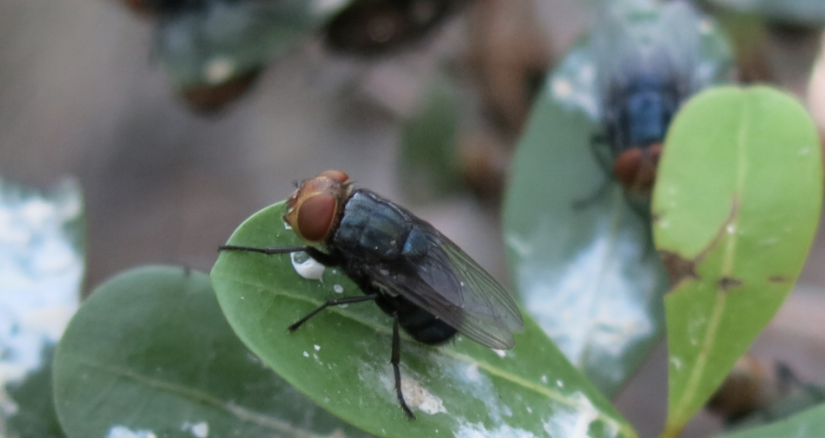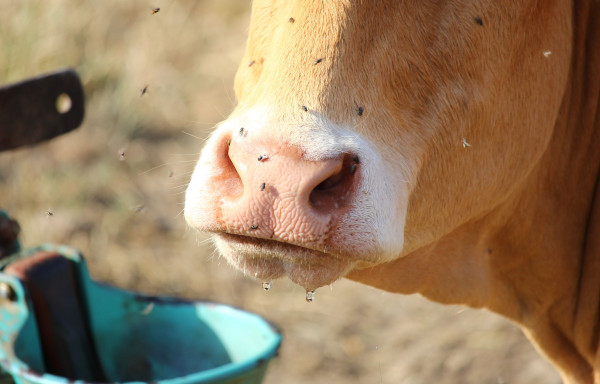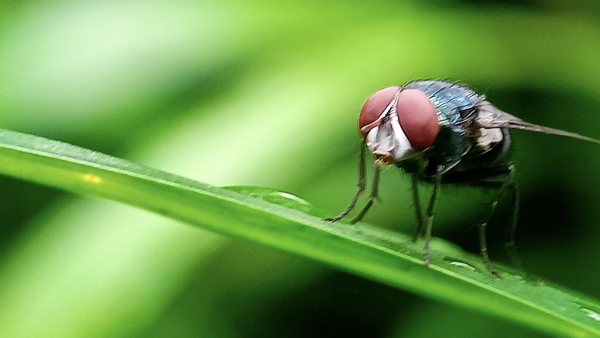
A Fly Of A Different Color
A serious potential animal health problem looms on our doorstep. For approximately the past three years, public health officials have been monitoring the movement of Cochliomyia hominivorax, better known as the New World screwworm, from Central America northward. The problem with this particular insect species is that the female fly lays eggs near wounds on living animals—or even people—as opposed to typical blowflies that lay eggs on dead animals. The larvae, or maggots, can burrow into living flesh, thus giving them the common name of screwworm.
To make matters worse, the screwworm larva can even burrow into animal flesh near mucous membranes, such as near body orifices, and even eyes, ears, and nostrils. This can cause severe pain, infection, and irreparable damage to the affected animal if not caught quickly and treated appropriately. For livestock, this can be a life-threatening problem as infestations can occur rapidly in animals that aren’t inspected often. Even though large economic losses can occur with livestock myiasis (fly larva infestation), this insect does not discriminate, and any animal can serve as a host. Even pets and humans are at risk, which makes this more than just a livestock and wildlife problem.
Screwworms had been a problem in South, Central, and even North America for decades, going back to the early 1900s. Prior to the 1930s, attempts to control them focused primarily on identifying affected animals and employing mostly ineffective treatments, as well as isolation for individual animals that survived. As with any insect capable of using both wild and domestic animals as hosts, early efforts to eradicate or control the devastating screwworm were had little success.
In the 1930s, this began to change with new research, when three scientists—Drs. Emory Cushing, Edward Knipling, and Raymond Bushland—identified key concepts that helped control this problem. The first was that the fly responsible was a different species from the blowfly, which lays eggs only on dead animals, a fact that had not been definitively known before. The screwworm fly has only a slight color difference that is very hard to discern from the regular blowfly.
They also identified that these pests could be controlled by releasing sterile male flies into the wild. This technique works because the female screwworm fly only mates once. If that single mating is with a sterile male fly, then the eggs will not hatch. The life cycle of C. hominivorax is approximately 20 days long, and if enough sterile male flies are introduced into the wild population, the species cannot reproduce effectively. These scientists helped to perfect the mass breeding of sterile male screwworm flies for research purposes.

Photo by wirestock
By the 1950s, radiation techniques had been developed that could render lab-produced male flies sterile. This is known as Sterile Insect Technique (SIT). As this research progressed, funding from the United States Department of Agriculture (USDA) helped establish the first large-scale insect production facility in Florida, capable of producing 50 million sterile male flies per week. Over the next several years, screwworm infestation disappeared from Florida. During this time, eradication efforts continued in Texas and the southwestern US, as new sterile fly production facilities were funded and constructed. By 1966, the US was declared free of indigenous screwworm outbreaks; however, since they continued to survive in Mexico through livestock and wildlife migration, occasional outbreaks occurred in Texas. An outbreak near the Florida Keys was reported in deer as recently as 2016.
As time went on, the USDA-led screwworm eradication efforts targeted Mexico to help fund SIT production facilities there, as well as in Panama. Their strategy was that if the US helped control this problem in Mexico and Central America, then the US would have a buffer barrier to C. hominivorax populations from those regions. Currently, the USDA maintains a sterile fly production facility in Panama that has the capability to produce approximately 100 million sterile flies a year.
However, with recent reports of new screwworm infestations in Mexico, as close as 700 miles from the US border, many experts question whether the current production of sterile male flies can keep up with demand, and suggest new facilities may be needed.
In May 2025, the USDA announced the suspension of livestock and horses entering the US along the southern border to decrease the chance of animals entering that may carry the New World screwworm. The USDA has stated that it will continue to monitor and collaborate with Mexico, Panama, and other Central American countries on surveillance, education, limited animal movement, and the implementation of continued sterile insect dispersal techniques.
Many people feel that we are in a perilous situation, not just due to the potential impact of an approximately $2 billion loss on the Texas cattle industry alone, but also for the safety of all animals and humans. Recently, senators from Texas and New Mexico have pushed for funding to build more sterile fly facilities to help combat this imminent threat.

Photo courtesy of USDA-APHIS
On June 18, US Secretary of Agriculture Brooke Rollins updated their multi-pronged approach to this problem. She stated that the USDA will be spending $21 million dollars on revamping a retired sterile fly production facility in Texas at Moore Air Base that potentially can produce up to 100 million sterile flies per week.
“We have the proven tools, strong domestic and international partnerships, and the grit needed to win this battle,” Rollins said in a press release.
When added on top of the sterile flies currently produced in Panama, the potential sterile fly production will be more than doubled. The USDA will continue working with and within Mexico to help them keep screwworm flies and larva as far from our southern border as possible. This also includes intensive border inspections as well as restrictions on livestock movement described as a ”barrier zone of vigilance.” In addition, building a completely new facility in the US to complement Moore Air Base is being strongly considered.
The USDA has indicated they will continue to work extremely closely to support experts and regulatory authorities of southern border states that would be most at risk, at least initially, in an outbreak in the US. Lastly, the agency has reiterated its commitment and collaboration with experts in the private and academic sectors to research and innovate new potential control techniques.
This problem is real—not only for our livestock industries but for the health and well-being of our pets and ourselves. We encourage constituents to contact their legislators, express their awareness of this potential crisis, and ask how they plan to support efforts to address it by backing this legislation.
Follow us on LinkedIn for the latest updates on all things happening here at BSM Partners.
About the Author
Dr. Bradley Quest, DVM, is the Principal Veterinarian at BSM Partners. He has practiced clinical veterinary medicine, developed and tested hundreds of pet food and health products, performs extensive animal health research, and helps navigate pet food ingredient approval for clients.
This content is the property of BSM Partners. Reproduction or retransmission or repurposing of any portion of this content is expressly prohibited without the approval of BSM Partners and is governed by the terms and conditions explained here.